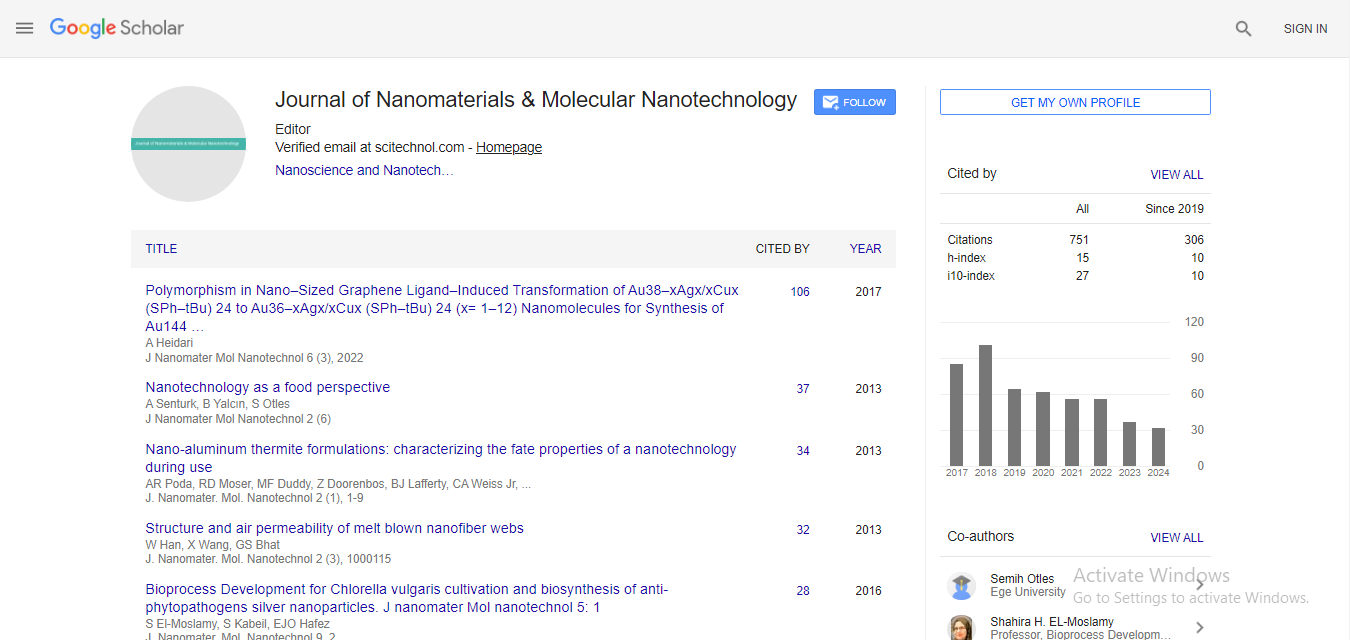Editorial, J Nanomater Mol Nanotechnol S Vol: 0 Issue: 1
Graphene: Emerging Trends, Prospects and Challenges
| Sandeep Kumar Vashist* | |
| HSG-IMIT - Institut für Mikro- und Informationstechnik, Georges-Koehler-Allee 103, 79110 Freiburg, Germany | |
| Corresponding author : Sandeep Kumar Vashist PhD The Head of Immunodiagnostics HSG-IMIT - Institut für Mikro- und Informationstechnik, Georges-Koehler-Allee 103, 79110 Freiburg, Germany E-mail: sandeep.kumar.vashist@hsg-imit.de |
|
| Received: March 25, 2013 Accepted: March 27, 2013 Published: April 02, 2013 | |
| Citation: Vashist SK (2013) Graphene: Emerging Trends, Prospects and Challenges. J Nanomater Mol Nanotechnol S1 doi:10.4172/2324-8777.S1-e001 |
Abstract
Graphene: Emerging Trends, Prospects and Challenges
Graphene has been extensively used in numerous multifarious applications during the last decade due to its unique properties, which include large surface-to-volume ratio, unique optical properties, excellent electrical conductivity, high carrier mobility, high carrier density, high thermal conductivity, room temperature Hall effect, ambipolar field-effect characteristics, high signal-to-noise ratio, and extremely high mechanical strength. It is a two-dimensional planar sheet of sp2-bonded carbon atoms packed densely in a honeycomb crystal lattice. The mass production of graphene is done by chemical vapor deposition (CVD) and chemical or thermal reduction of graphene oxide. Several chemical modification, biomolecular immobilization and nanocomposite formation strategies for graphene have also been developed.
| Graphene has been extensively used in numerous multifarious applications during the last decade due to its unique properties, which include large surface-to-volume ratio, unique optical properties, excellent electrical conductivity, high carrier mobility, high carrier density, high thermal conductivity, room temperature Hall effect, ambipolar field-effect characteristics, high signal-to-noise ratio, and extremely high mechanical strength. It is a two-dimensional planar sheet of sp2-bonded carbon atoms packed densely in a honeycomb crystal lattice. The mass production of graphene is done by chemical vapor deposition (CVD) and chemical or thermal reduction of graphene oxide. Several chemical modification, biomolecular immobilization and nanocomposite formation strategies [1] for graphene have also been developed. | |
| Graphene-based sensors/devices [2,3] have also been employed for the detection of biomolecules, analytes, cells, gases, pH, environmental contaminants, pharmaceutical compounds and micro-organisms. It has been used for the development of fieldeffect transistors (FET) due to its high carrier mobility and low noise. Graphene oxide has also been used as a food packaging material due to its excellent anti-bacterial properties. Moreover, graphene is ideal for electrochemical biosensing due to the direct electron transfer between enzyme and electrode surface, the superior analytical performance, negligible interference from biological substances and drug metabolites and excellent anti-fouling ability of graphenefunctionalized electrodes [4,5]. Due to its high electrical conductivity and high optical transparency, graphene has great potential for developing transparent conducting electrodes for liquid crystal displays, touchscreens, organic light-emitting diodes and organic photovoltaic cells. It is an appropriate material for spintronics due to its small spin-orbit interaction and absence of nuclear magnetic moments in carbon. Moreover, it can significantly improve the energy storage density of the existing ultracapacitors due to its extremely high surface area to mass ratio. | |
| The commercially-available graphene is crystalline or flake form of graphite that consists of many graphene sheets stacked together (Figure 1). Bilayer graphene has extreme potential for optoelectronic and nanoelectronic applications due to its tunable band gap, quantum hall effect and potential for excitonic condensation. Graphene oxide papers and graphene oxide flakes in polymers have peculiar chemical and enhanced photo-conducting properties. Graphene-based membranes will be highly useful for the cost-effective distillation of ethanol at room temperature as they are impermeable to gases and liquids but allow water vapours to pass through. Similarly, graphene filters for better desalination, and graphene nanoribbons and graphene quantum dots for ultrasensitive analyte detection have also been made. | |
| Figure 1: Single- and multi-layered graphene. The yellow, red and blue groups in single-layered graphene are hydroxyl, ether and carboxyl groups, respectively. Reproduced with permission from OMICS Publishing Group [8]. | |
| There is a need to improve the synthesis of graphene using facile, reproducible and scalable preparation methods. The evaluation of toxicity and biocompatibility of graphene is still a challenge for the scientific community due to the lack of international guidelines for evaluating the toxicity of nanomaterials [6]. Moreover, graphenebased sensors/devices need to comply with the industrial and healthcare requirements [7,8] to be commercially-viable. However, based on its numerous advantages and superior analytical performance, graphene will be extensively employed in a broad range of applications. | |
References |
|
|
|
 Spanish
Spanish  Chinese
Chinese  Russian
Russian  German
German  French
French  Japanese
Japanese  Portuguese
Portuguese  Hindi
Hindi 



